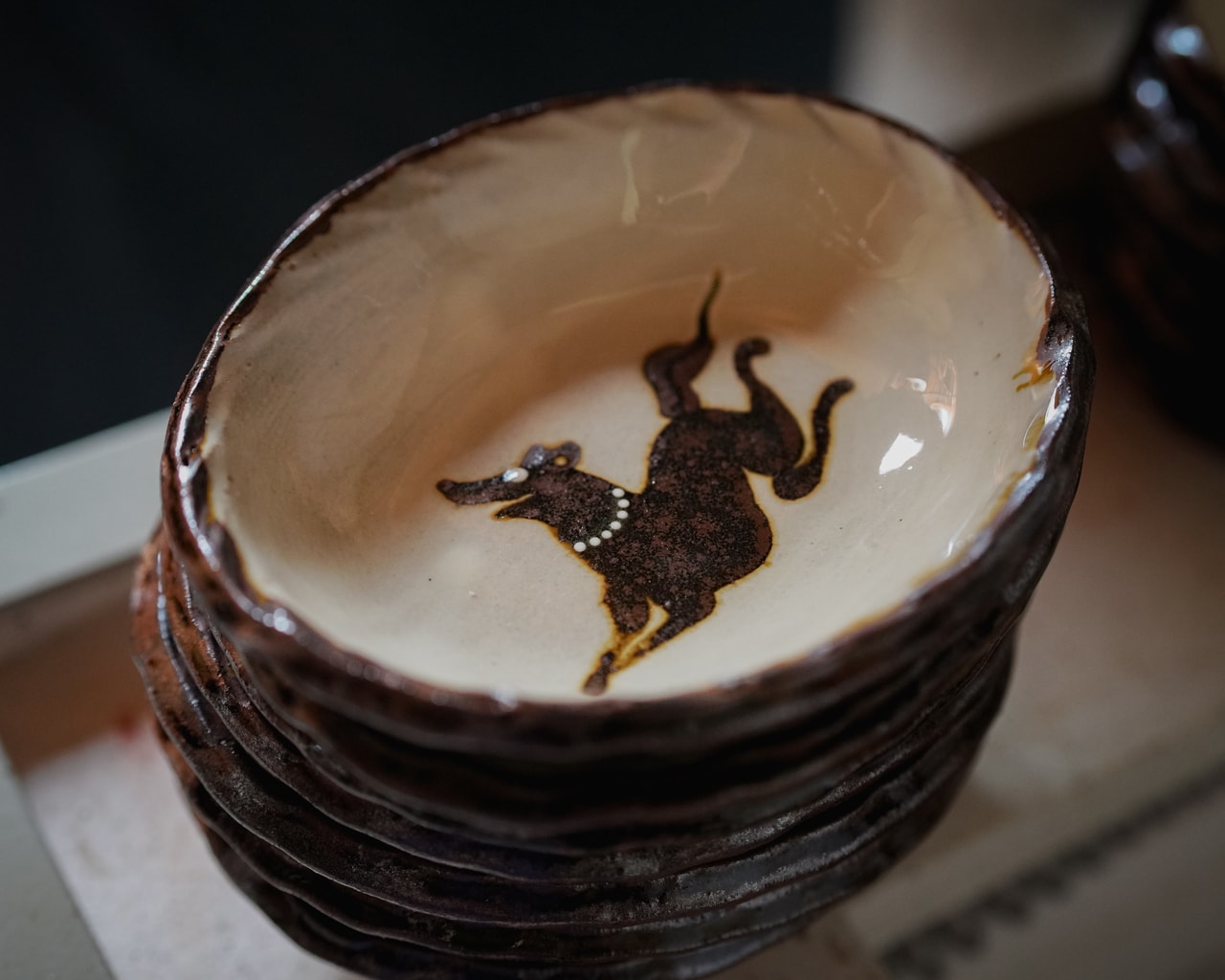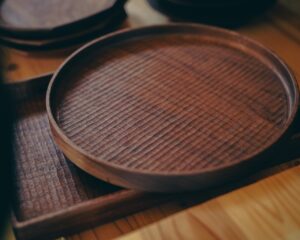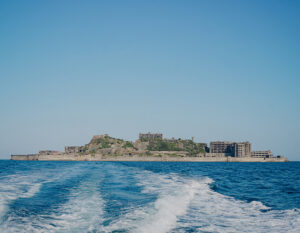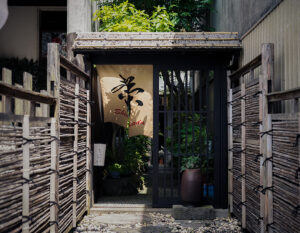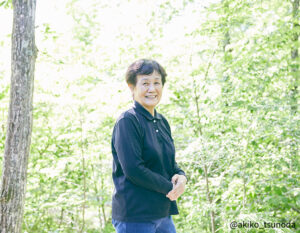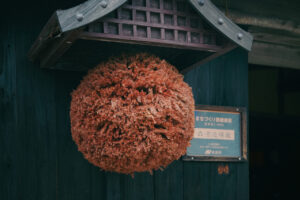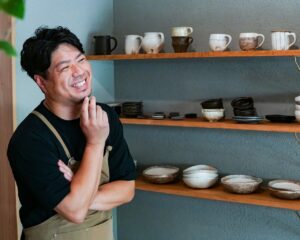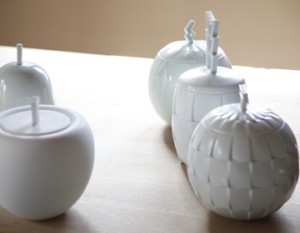Teppei Kojima, a ceramic artist who produces pottery under the name “Tetsu Kobo” in Aburagi-cho, Nagasaki, produces a large number of everyday-use vessels using traditional techniques and raw materials he has researched independently.
The “living creatures” series, which depicts the “living forms” of animals he has seen with his own eyes, and other works
have a unique appearance that is hard to find anywhere else.
Typical slipware has a soft, rounded comb pattern and a lattice pattern, but Teppei Kojima, who has a studio in Nagasaki City, creates slipware with a distinctly unique appearance using creatures as a motif. We visited ” Tetsu Kobo ” to meet Mr. Kojima, who is almost entirely self-taught in pottery making.
What is slipware?

Slipware is pottery that is decorated with a muddy clay called ” slip ” and fired. The unique texture of slipware, represented by soft, rounded stripes and wave patterns, has a solid presence that can only be achieved by hand.
Vessels born in England and raised in Japan
Slipware, which was made actively in England from the 18th to the 19th century, was mainly used as oven dishes, and was brought to the table as it was baked, supporting the daily dining table. Slipware was eventually swallowed up by the wave of industrialization and disappeared as mass-produced products became more common, but the founders of the Mingei (folk art) movement, including Muneyoshi Yanagi, took notice of slipware in faraway Japan. Their encounter with English potter Bernard Leach brought slipware back into the spotlight, and it gradually gained recognition, becoming increasingly popular in the 2000s.
Infinitely Expanding Slipware Patterns
Slipware is characterized by stripes and arrow feather patterns with rounded, soft curves. Well-known methods include drawing patterns on top of freshly-dried decorative clay with a dropper or tube, or scratching patterns on top of it with a stick. Because each piece is hand-painted, no two vessels are the same, and the artist’s individuality overflows into the slipware, which is another interesting aspect of slipware. Among them, Nagasaki-based ceramic artist Teppei Kojima continues to create unique slipware with motifs of living creatures.
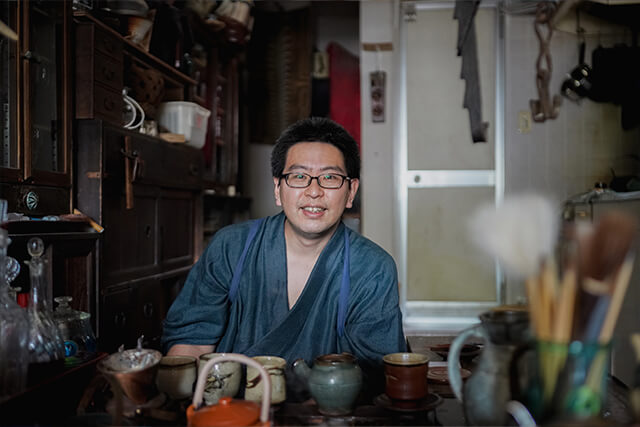
From a Salaried Worker to a Potter
A room in a small building in Nagasaki City. When you step into “Tetsu Kobo,” your eyes are greeted by a hearth and the old tools that surround it. Books on folk arts and crafts lined the shelves, creating a world that resembled a small, cozy restaurant. Mr. Teppei Kojima, dressed in a kimono, greeted us.
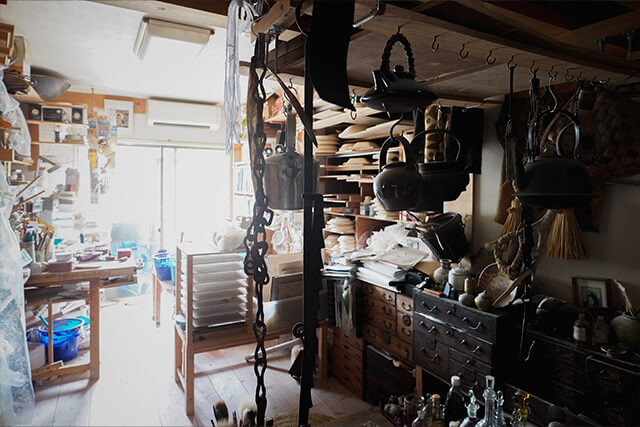
The money is just enough to live on. I want to do what I love.
He was born in Nagasaki City. After graduating from university, he worked at a restaurant in Tokyo, but decided to leave and return to Nagasaki to find what he really wanted to do after spending too much time going back and forth between home and work. After that, he worked as a waterproofer, in sales, and as a manual laborer, but none of these jobs lasted long. On the other hand, Kojima began to take up ceramics after returning to his hometown and became absorbed in the art. He has loved making things ever since he can remember, and it was a precious time for him to lose himself in it. What he has always held in his heart is, ” All I need is enough money to make a living. I want to do what I love. It was a natural progression for him to pursue a career in ceramics.
When I was in college, there was a potter who stayed at my place of residence, and we would spend about a week fishing every day and drinking and talking with each other. Seeing his lifestyle, I envied him and thought, “If only I could become a potter, I could have such a life.
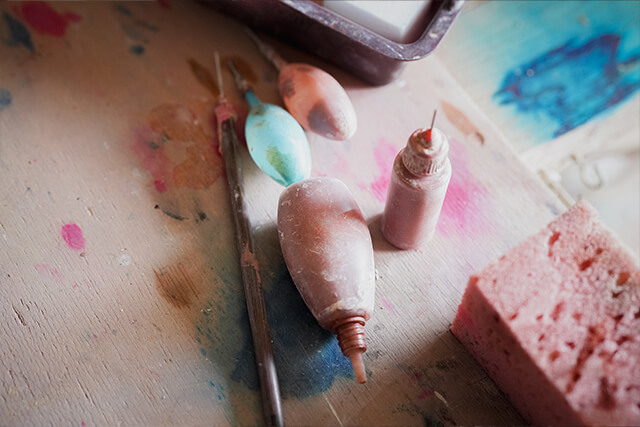
Painting for a change became his own style
Shortly after he started taking pottery classes, Kojima began to pay attention to slipware, which was gaining attention after a certain art magazine ran a feature on it. The teacher taught him the technique and he tried it at home, but “line drawings were difficult for an amateur and did not turn out well,” he recalls. Then, he happened to come across a book that featured the work of the late Kenji Funaki, one of Japan’s leading slipware artists, who had trained at Bernard Leach’s kiln in England.
He had trained at Bernard Leach’s kiln in England and was one of the most famous slipware artists in Japan. I tried drawing them myself as a change of pace, and to my surprise, it turned out to be a good idea. I thought that painting might be better suited to me than lines.
He spent many nights at home until midnight, painting on vessels and then bringing them to the class to be fired. Finally, “My teacher told me to buy my own kiln,” he said, and he bought an electric kiln for himself. He taught himself to study glazes and slip techniques.
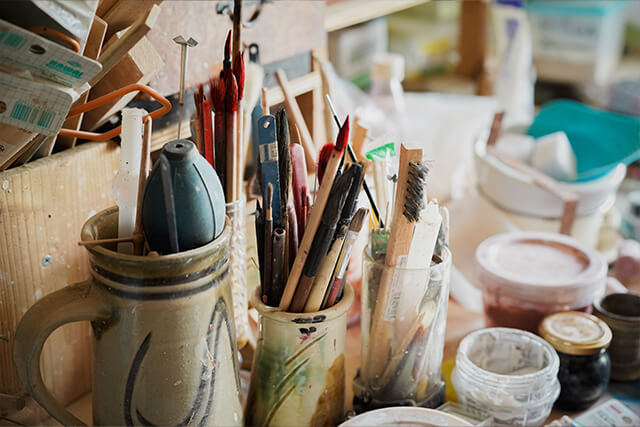
Becoming a Professional in Just Three Years
In 2011, two years after he began making ceramics, Kojima received the Nagasaki Ceramics Exhibition’s Jury’s Special Prize. The following year, he won the Grand Prize in the category of ceramics for daily life at the same exhibition. In the same year, he was also approached by the ” Ginza Handicrafts Direct Seller ” at Matsuya Ginza, and this was the catalyst for his professional career.
I was asked to stay at the gallery for a week,” he said. But I was an office worker at the time, and I couldn’t take a week off work. If I refused, I thought, I would never become a potter.
Kojima decided to quit his job and devote himself to ceramics. Since then, he has steadily built a professional career, continuing to participate in the “Ginza Handicrafts Direct Selling Shop” every year.
Kojima-san is known for his paintings of living creatures.
Mr. Kojima is known for his vessels with lively creatures painted on them. In addition to his standard deer, octopus, and rabbit, in recent years, his yokai (monsters) series, including Nurikabe, Hitotsukomen, and Oni (ogres), have become popular.
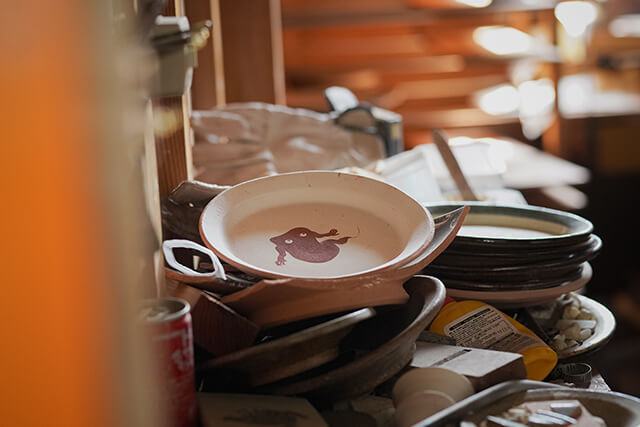
Kojima’s view of the world, completed in three minutes
Slipware is made by pouring mud plaster (deisho, slip: a mixture of water and clay in a muddy state) on a freshly dried vessel, and then immediately painting over the top with another layer of mud plaster all at once. If it dries out, you will not be able to paint,” he said. Each dish takes only about three minutes to paint,” says Kojima.
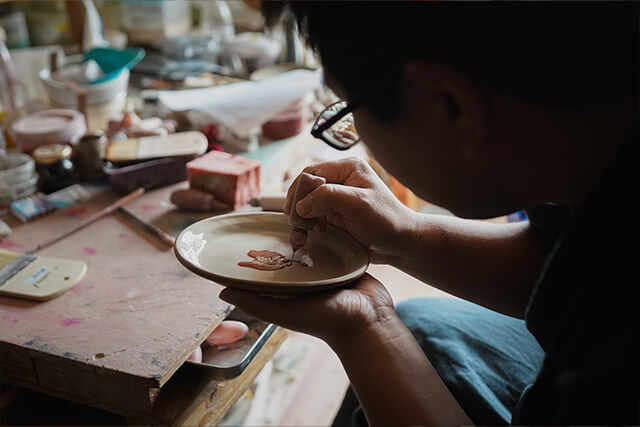
Watching him paint, the process looks easy enough, but he has the experience to handle the pot with the right amount of pressure when holding the dropper filled with mud plaster. Even a single dot can change its balance if its size is slightly different,” says Kojima. It is really difficult to adjust the strength and weakness of the spot with the dropper.
If the amount of water in the mud plaster is too much, the painting will spread out and will not be finished beautifully, and the drying process is also prone to cracks and deformation due to the shrinkage rate. Conversely, too little water can cause the colors to peel off during the firing process, making the adjustment of mud plaster concentration an extremely important factor in slipware.
The speed at which the painting soaks into the slipware, the saltiness with which the lines spread, and the colors that emerge when the slipware is fired are all factors that must be considered when adjusting the density. You adjust the density while calculating these things. It is really difficult to make it thicker or thinner. Some people use a densitometer.
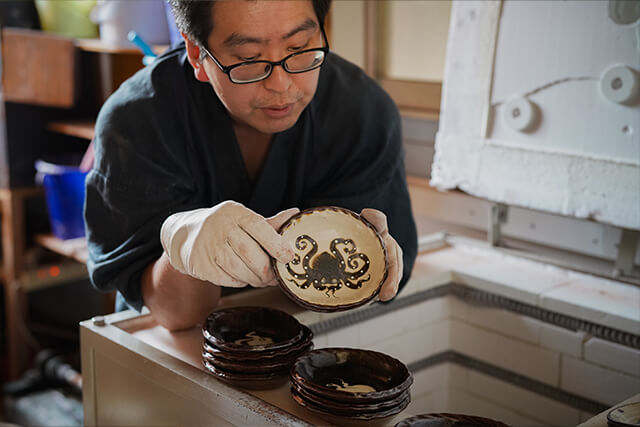
As much as possible, I use natural products that I made myself.
For the mud plaster, he uses bengara, a natural pigment. For the glaze, he uses a rare stone called kimachi-shiroishi, produced in Shimane, combined with a base of wood ash that he cooked himself. I can buy the ash if I want to, but I have to be careful about what kind of wood is used and where it comes from, and sometimes there are things other than wood mixed in, such as magazines and newspapers, so it is safer to make it myself,” he says. I try to make what I can myself,” he says.
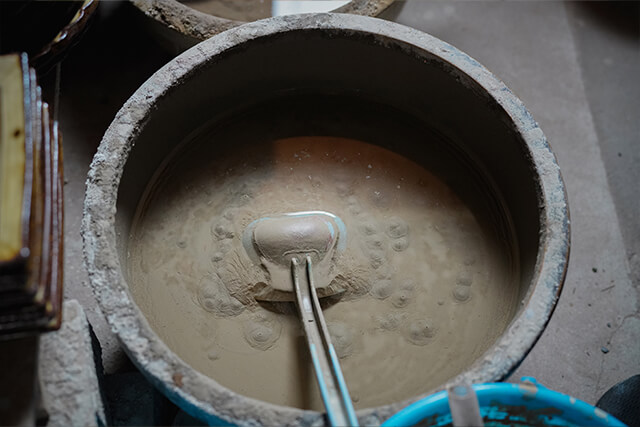
Perhaps because of this, many of Kojima-san’s slipware have a somewhat gentle, natural feel to them, and his paintings have a light, unique, yet relaxed look to them.
They come in a variety of sizes and shapes. The 7″ plates are deep and easy to use for salads and oden, while the 5″ flat plates can be used as cake plates or serving plates. The 3″ bean plates are also carefully painted, and the expressions and lively movements of the animals and monsters never tire of being seen.
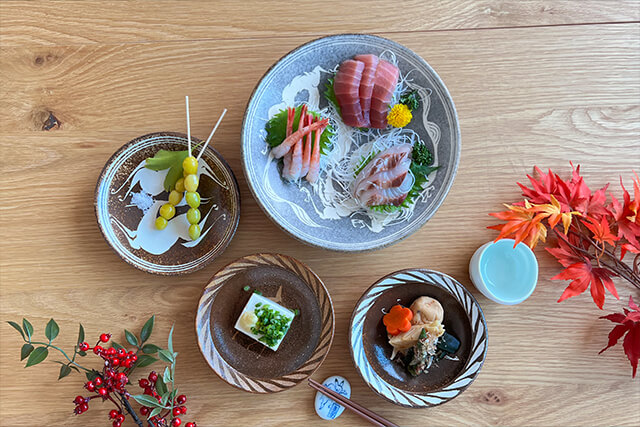
Seeking to establish his own style
Kojima says with a wry smile, “I’ve never been good at drawing pictures, so sometimes it’s hard for me. But, oddly enough, it was after seeing the late Kenji Funaki’s vessels that he began to draw pictures of living creatures, which led him to the path he is on today. Recently, he has made it a daily routine to draw ink paintings using ink he has ground himself, hoping to “improve my painting even if only a little.
At the same time, he is now adding to his collection of vessels made with sumi-hajiri ink. Sumi-Hajiri is a long-established technique of removing the white from the ink by utilizing the ink’s ingredients, and is contrasted with slipware, which is characterized by rounded corners, in that it produces a crisp, sharp look.
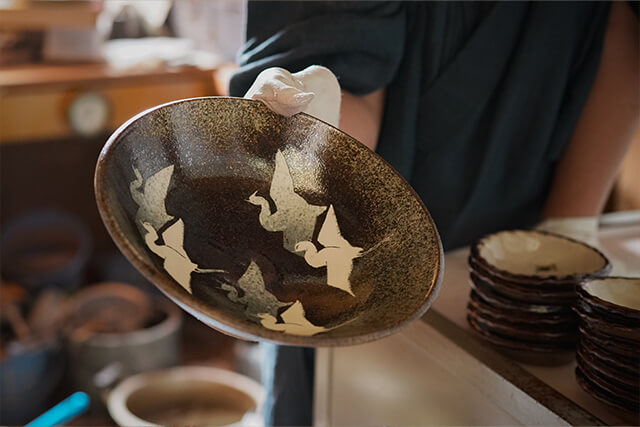
I didn’t go to pottery school, and I don’t have a proper teacher. That’s why I really have no choice but to do it as a round-robin competition. I think that if I continue to do this for a long time to come, one day I will be able to paint my own pictures and get closer to my own style,” he says with a cheerful laugh.
Kojima has found the right place to do what he truly loves. She says that although she took a slight detour, she has turned it all into a learning experience, and that her work is somehow gentle and warm. The mysterious sense of security that makes us want to pick up a piece of her work when we need a breather in our daily lives is a result of her commitment to making her customers happy. We hope you will add one of these pieces to your collection. You will find yourself with it in the front row of your cupboard.
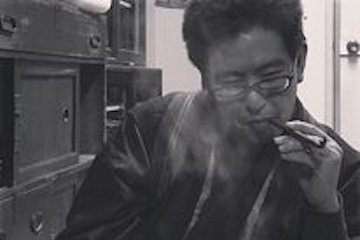
I have been completing my work by clearing each challenge one by one in my own way. I am proud to say that these are my own unique vessels with my own unique twist. I hope you will keep it with you and use it a lot.



